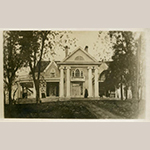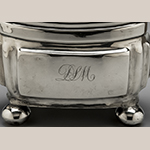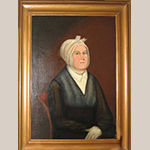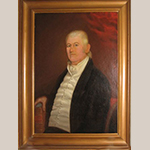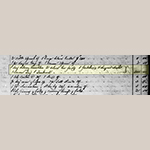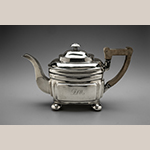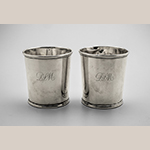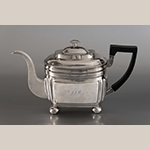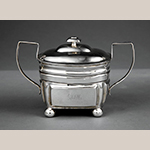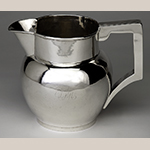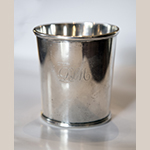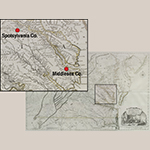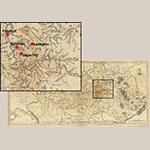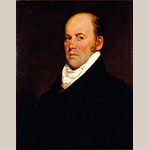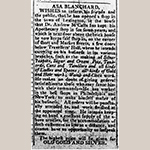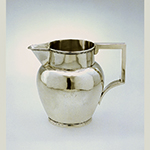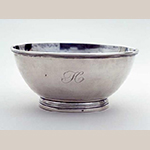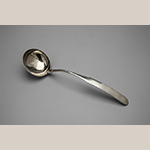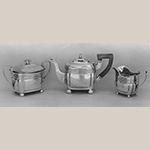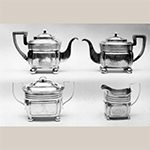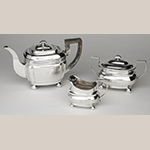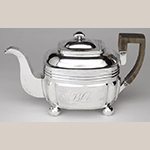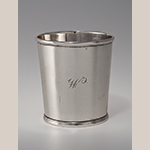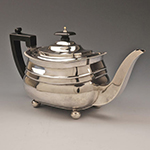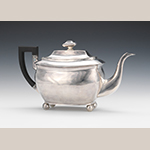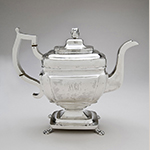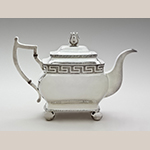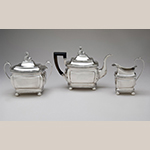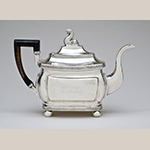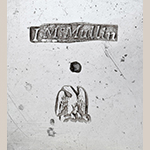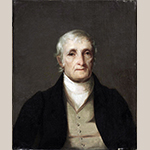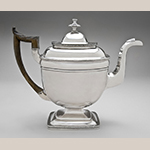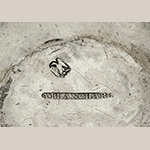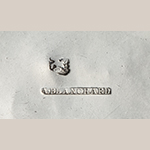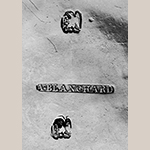Brightly reflecting the August afternoon sun, the impressive silver service is displayed on a round mahogany table at the center of an elaborately appointed parlor. Along with the tea service—which includes a pair of matching teapots—there are a pitcher, tankard, and a dozen beakers. An elderly woman, aged yet stately, sits at the table nostalgically stroking the polished surface of the teapot nearest her. The year is 1868 and Susan Mitchum Ball is dying. She has asked her adult children to gather that day at Maple Hill [Figure 1], the plantation carved from the wilderness by her father and mother in the 1780s, situated four miles south of the Kentucky town of Versailles. She wants each of them to have and cherish—just as she has—the heirloom silver that their grandparents had commissioned fifty years earlier from the Lexington silversmith Asa Blanchard.
— ♦♦◊♦♦ —
While the above scenario is loosely based on documentary evidence, eight pieces of silver marked by Asa Blanchard with the same engraved monogram: “D S M” (Figure 2) have surfaced over the past two years. The silver—two teapots, a sugar bowl, pitcher, and four beakers—were all purchased and owned by Susan Mitchum Ball’s parents, Dudley and Susannah Mitchum (Figures 3 and 4).[1] [2] According to family history, the silver was “divided into parcels over a century ago.”[3] It is likely that Susan Mitchum Ball distributed the silver among her adult children—Dudley Mitchum Ball, Mary Ball Campbell, Susan Ball Edmonds, and Mariah Ball Gray—sometime before her death in 1868.[4] The recently identified teapots, sugar bowl, pitcher and beakers are part of a larger service owned by the Mitchum family: the 1831 probate inventory of Dudley Mitchum’s estate listed “1 doz silver tumblers, 2 silver tea pots, 1 pitcher, 1 sugar dish, 1 cream jug, 1 tankard,” with a combined valued of $400.00 (Figure 5).[5]
MESDA acquired one of the Mitchum teapots and two beakers (Figures 6 and 7) in June 2014 directly from a descendant of Susan Mitchum Ball’s daughter Mary Ball Campbell.[6] The Colonial Williamsburg Foundation purchased the other Mitchum teapot (Figure 8) at public auction in 2013.[7] A covered sugar bowl (Figure 9), also marked by Blanchard and engraved with the “D S M” monogram, was included in that same auction but purchased by an unidentified buyer.[8] The pitcher is owned privately and was recorded by the Speed Art Museum’s Kentucky Online Arts Resource (KOAR) (Figure 10).The remaining two pieces of identified Mitchum silver, a pair of beakers, reside in a private Lexington, Kentucky collection (Figure 11).[9] With the exception of the MESDA teapot and beakers, no provenances were attached to the Mitchum silver when the pieces were purchased—and the family’s history associated with the MESDA teapot and beakers inaccurately recorded its original owners as a generation earlier and associated with a paternal instead of a maternal line of descent.
Where is the other Asa Blanchard silver engraved with the “D S M” monogram? Remaining to be found are eight beakers, a cream jug, and a tankard from Dudley Mitchum’s 1831 inventory. Perhaps some of it survives in another branch of the family. Publishing the provenance of the silver that has been identified in the past two years may bring the other Mitchum silver to light. Contextualizing the Mitchum family within Kentucky’s early historical and cultural landscape will demonstrate that Dudley and Susannah Mitchum were active participants in pioneering both the region’s frontier and subsequent material refinement.
— ♦♦◊♦♦ —
Dudley Mitchum was born in 1754 in the Rappahannock River parish of Christ Church, Middlesex County, Virginia to James Mitchum and Elizabeth Dudley (Figure 12).[10] In 1779, he married Susannah Allen, who was born in 1760, the daughter of Joseph and Sarah Allen. The Allens lived up the Rappahannock River near Fredericksburg, in Spotsylvania County. Shortly after their marriage, Dudley Mitchum acquired five hundred acres of land in Kentucky from Captain John Craig, an early settler of Central Kentucky who was also from Spotsylvania County.[11] The Craigs and the Mitchums were members of the “Traveling Church” of Baptists that migrated collectively from Spotsylvania County down the Great Wagon Road and through the narrow, winding Cumberland Gap to Kentucky in 1781.[12] [13]
Dudley and Susannah Mitchum settled on land in what would become Woodford County and established Maple Hill, situated near Clear Creek on a “splendid body of rolling bluegrass land, with numerous springs of excellent stock water” (Figure 13).[14] In 1782, Dudley Mitchum took part in the defense of Bryan’s Station, five miles northeast of Lexington.[15] The British and Shawnee Indian attacks on the Baptist settlers were frequent in the early 1780s and Bryan’s Station was neither the first nor the last such encounter.[16] Taken together, these confrontations proved that “the pioneer Baptists of Kentucky could fight and endure as well as pray.”[17]
Maple Hill was likely a modest enterprise for the first decades of its existence—how modest we will never know since the 1790 and 1800 census records for Kentucky were burned when the British sacked Washington, DC during the War of 1812. The Mitchums almost certainly had an eighteenth-century cabin or house on the property, probably very similar to the one described in 1784 by John Taylor, minister of the Clear Creek Baptist Church: in a “little cabin (sixteen feet square, with no floor but the natural earth, without table, bedstead or stool)… I had nothing before me but hard labour, being entirely in the woods.”[18] As the early settlers reaped more economic profit from their land, however, their log cabins were improved or completely replaced in the 1790s and early nineteenth century. Historian Craig Thompson Friend summarized this transformation: “Stamping a genteel architectural imprint on the landscape was necessary as the gentry observed around them the persisting markers of pioneer culture.”[19]
Central Kentucky in the early nineteenth century was an agricultural powerhouse that generated economic upward mobility, and the “created wealth widened the early classes that had tended to appear in Kentucky society.”[20] By 1810, Mitchum owned twenty-one slaves at Maple Hill, a number that is on par with the most prosperous of his neighbors.[21] The 1820 Federal Census recorded him as owning twenty-two slaves. By the time of Mitchum’s death in 1831, Maple Hill was a successful farm featuring a “genteel” house filled with refined goods, twenty slaves on the farm, and total estate value of $15,709.59.[22] From humble beginnings, the Mitchums resoundingly represent that critical generation who pioneered the region in the early 1780s and had, by the first decade of the nineteenth century, created what Craig Friend called “a middle class with expendable cash [and its] own ideas of respectability.”[23]
The family’s economic status benefited from years of incrementally improving agricultural profits at Maple Hill.[24] The decade from 1810 to 1820, in particular, may have propelled the farm’s success through the introduction of the steamboat for access to more competitive markets.[25] It was also during this decade that the Mitchams probably completely a major renovation of the manor house at Maple Hill, or built a completely new structure. The only known images of Maple Hill (see Fig. 1, for example) were made after several renovations to the structure, but vestiges of a Federal-period house can be seen in the front entrance, with its fan light and glass surrounds. A Greek Revival improvement in the 1840s is reflected in the first floor windows and columned portico. A Gothic Revival update, probably completed sometime after the Civil War, added the arched windows and peaked dormers on the second floor.
If the couple greatly improved their plantation house between 1810 and 1820, then that is also the decade in which they most likely purchased their silver. Historian and curator William Barrow Floyd wrote: “Tradition has it that Mitchum filled two saddlebags full of silver dollars, loaded them on each side of his horse, and rode to Lexington, where Asa Blanchard fashioned them into the various pieces… .”[26]
— ♦♦◊♦♦ —
As early Kentucky’s most prolific and successful silversmith, Asa Blanchard’s shop and product are significant to the state’s material culture during its formative period and reflect the east-to-west migration of craftsmen in the early nineteenth century. The origins and training of Blanchard had been unknown for many years, but American silver scholar Cathy Hollan has solved the mystery. In her 2010 book Virginia Silversmiths, Hollan established that Kentucky’s Asa Blanchard (Figure 14) had begun his career as Asa Blansett, born circa 1770, probably in Dumfries, Virginia.[27] It is not yet known under whom he received his training as a silversmith, but he could have trained in Dumfries or in nearby Alexandria or Fredericksburg. A tantalizing clue to his training appeared in the first known advertisement that Blanchard placed after he relocated to Lexington, Kentucky in 1806. In the notice, dated 28 February 1807, he claimed to have “worked in the best shops in Philadelphia and New York, to make himself a master of his business” (Figure 15).[28] Documentary evidence proving that Blanchard worked in either of those cities has yet to be found, and none of the silver bearing his mark has a history of being made anywhere but in Virginia or Kentucky. It must also be considered that Blanchard may have exaggerated his training to impress potential customers in Lexington.
Asa Blanchard’s move to Lexington in 1806 coincided with the mass migration of merchants and craftsmen to the region. Craig Friend wrote that the “mad rush of merchants into trans-Appalachia symbolized the quick conversion of the region from subsistence into a pioneer market economy. Any farmer could participate, and any merchant could become a middleman.”[29] Thus, Blanchard’s relocation to Kentucky parallels Dudley Mitchum’s migration over twenty years earlier. Just as Mitchum created wealth through agriculture and husbandry at Maple Hill, over the next thirty-two years Asa Blanchard became an active participant in Lexington’s artisan-merchant community. When he died in 1838, his estate was valued at $40,000.[30] A handful of tea services, pitchers, and a bowl survive with Asa Blanchard’s mark, as do dozens of beakers and scores of spoons and ladles, most from his career in Kentucky (Figures 16 through 18).
The Mitchum teapots, sugar bowl, and beakers are consistent with the construction and design of other silver that came out of Blanchard’s shop (Figures 19 through 23). The bodies are not raised from a disc but made from rolled sheet silver and seamed, as would be expected in an early-nineteenth-century American shop.
The rectangular shape of the teapots and sugar bowl, as well as their ball feet, can be found on contemporary English and English-influenced silver made in New York and Philadelphia (Figures 24 through 27). The strong influence of New York and Philadelphia design on Blanchard’s silver supports his claim of having worked in those cities.[31]
Most interestingly, the raised side panels on the bodies of Blanchard teapots, cream pitchers, and sugar bowls seem to directly reference Philadelphia work, especially the teapot by Samuel Richards Jr. (see Fig. 26) and a tea service by silversmith Anthony Rasch (Figures 28 and 29), who worked in Philadelphia until 1820 and afterwards in New Orleans, Louisiana.[32] The Rasch service, with the exception of the finials, is remarkably related to Blanchard’s tea service designs.
Although it is tempting to conclude that Blanchard worked with Rasch, another connection may explain a more-than-casual resemblance of Blanchard’s silver to that made in Philadelphia.[33] In her 2013 book Philadelphia Silversmiths, Cathy Hollan established that the spread eagle mark that often accompanies Asa Blanchard’s mark on his silver is the manufacturer’s mark of Philadelphia silversmith John McMullin (Figure 30 through 32).[34] An informal survey of forty-nine pieces of Blanchard hollowware resulted in twenty-five, or 51 percent, bearing the spread eagle mark (Figures 33 through 35).[35] A more comprehensive study is required to form any firm conclusions, but it seems that if Asa Blanchard purchased silver from McMullin, he may have also been producing a significant amount in his own shop.
The Mitchum service is unusual because the two hot beverage pots are of identical sizes.[36] From the late eighteenth century onward, it was common, if not customary, for silversmiths to produce tea services that included a coffeepot and a slightly smaller teapot.[37] Why would the Mitchums have purchased a service from Blanchard with two teapots? Janine Skerry, Curator of Metals for The Colonial Williamsburg Foundation, suggested that one pot was for green tea and the other for black tea, just as silver tea caddies were often made with two sections, one for green tea and one for black tea. There is very little evidence to be found about the topic in the primary and secondary sources of tea consumerism or hot beverage vessels.[38] That said, two citations have been found that validate the idea that one of the Mitchum teapots was for green tea and the other for black tea.
The first comes from an early nineteenth century collection of letters written by an Englishman, Reverend Thomas Talbot. During a visit to a relation’s country estate, Talbot wrote that, if there were no houseguests, breakfast “of the plainest description” was taken. But when guests were staying, a table was set with “an urn and cistern of black tea at one end—ditto of green tea at the other and coffee at the side.”[39] The second comes from a 1989 Christie’s London auction catalog titled The Glory of the Goldsmith: Magnificent Gold and Silver from the Al-Tajir Collection. One of the lots for sale was a two-teapot service that was cataloged with a note: “Silver services of the late 18th and early 19th century sometimes include two teapots, but these are usually of the same size, one for black tea and one for green.”[40]
— ♦♦◊♦♦ —
Susannah Allen Mitchum died in 1833, two years after her husband. Their youngest daughter, Susan Mitchum Ball, and her husband, John Ball, inherited Maple Hill and its household contents. Tragedy struck the family again in 1833 when John Ball died.[41] Although Susan remarried in 1836, to an itinerant Baptist preacher named Benjamin Franklin Hall, she retained control of the plantation operation, enslaved workers, and her personal property.[42] When her son Dudley Mitchum Ball came of age in the early 1840s, he took over the operation of Maple Hill and turned it into one of Kentucky’s most celebrated stock horse farms.[43]
Maple Hill remained Susan Mitchum Ball’s residence until her death in September 1868. The family’s silver, most likely distributed among her grown children, was separated, and “some remained in Kentucky while other pieces have been taken elsewhere and some have been lost.”[44] By the end of the nineteenth century, portions of the service had traveled with Mitchum descendents to Missouri; by the first decades of the twentieth century some of it had been moved as far away as Oregon.
Today, two hundred years or so after two of Kentucky’s founding pioneers—Dudley and Susannah Mitchum—commissioned their silver service from Asa Blanchard, eight of the eighteen pieces have been identified. What has become of the remaining eight beakers, cream jug, and tankard recorded in Mitchum’s 1831 inventory? Somewhere there may be a cache of very fine silver marked by Asa Blanchard with the engraved initials “D S M” on their bodies. It is time for the Mitchum silver to be recognized and appreciated for its importance to Kentucky’s early material culture. The family’s silver symbolizes the successes attained by that important generation of Kentuckians—embodied by the Mitchums—who pioneered the frontier and fashioned a new society of refinement and respectability.
Gary Albert is Editorial Director at Old Salem Museums & Gardens and Editor of the MESDA Journal. He also serves as MESDA’s adjunct curator of silver and metals and can be reached at [email protected].
[1] For consistency in this article the family’s name is spelled “Mitchum”; several variations appear throughout historic documents, including “Mitcham,” “Micham,” “Mitchem,” and “Meachem.”
[2] Appreciation is extended to Daniel Ackermann, Associate Curator, MESDA, for his assistance in verifying the correct provenance of the silver to Dudley and Susannah Mitchum.
[3] In a 9 September 1988 letter from William Barrow Floyd to a Mitchum descendant, Floyd wrote: “The Mitchum silver was divided into parcels over a century ago, and it has been scattered subsequently. Some remained in Kentucky while other pieces have been taken elsewhere and some have been lost.” MESDA Accession File 5779.1-3.
[4] Susan Mitchum Ball had four living children in 1865, a son and three daughters: Dudley Mitchum Ball (1824-1900), Mary Ball Campbell (1826-1891), Susan Ball Edmonds (1829-1899), and Mariah Ball Gray (1830-1893). The 1850 Federal Census recorded her household with four of her children: Dudley Mitchum (age 25), William S. (age 22), Susan A. (age 21), and Maria M. (age 19). Her fifth child, Mary Ball Campbell (age 23), was living with her husband Enos Campbell in Fayette County, KY. William S. Ball died in 1863. For Dudley Mitchum Ball’s death date: Versailles Cemetery, online: http://www.findagrave.com/cgi-bin/fg.cgi?page=gr&GSln=Ball&GSfn=Dudley&GSbyrel=all&GSdyrel=all&GSob=n&GRid=100834329&df=all& (accessed 22 December 2014). For Mary Ball Campbell’s death date: Versailles Cemetery, online: http://www.findagrave.com/cgi-bin/fg.cgi?page=gr&GSln=Campbell&GSfn=Mary&GSby=1830&GSbyrel=before&GSdy=1895&GSdyrel=before&GSst=19&GScnty=1108&GScntry=4&GSob=n&GRid=100826154&df=all& (accessed 22 December 2014). For Susan Ball Edmonds’s death date: Versailles Cemetery, online: http://billiongraves.com/pages/record/Susan-A-Edmonds/3095839 (accessed 22 December 2014). For Mariah Ball Gray’s death date: Kentucky Deaths & Burials, 1843-1970, p. 193, no. 59, online: https://familysearch.org/ark:/61903/1:1:FW5W-13K (accessed 22 December 2014). For William S. Ball’s death date: Marion Cemetery, Perry County, AL, online: http://www.findagrave.com/cgi-bin/fg.cgi?page=gr&GSln=Ball&GSfn=William&GSmn=S&GSby=1831&GSbyrel=before&GSdy=1864&GSdyrel=before&GSst=3&GScntry=4&GSob=n&GRid=97182906&df=all& (accessed 22 December 2014).
[5] Woodford County, County Clerk, Will Book I, 1830-1834, 19 August 1831, pp. 128-132. Although he did not illustrate any of the Mitchum silver, William Barrow Floyd was the first to publish the Mitchum silver and Dudley Mitchum’s probate inventory, in “Kentucky Coin-Silver Pitchers,” The Magazine ANTIQUES, vol. 105, no. 3 (March 1974), 576-580. Appreciation is extended to Robert Leath, Chief Curator, VP Collections & Research, MESDA, and Jennifer Garwood, Curatorial and Research Associate, MESDA, for finding Dudley Mitchum’s inventory before Floyd’s citation was identified.
[6] MESDA Accession File 5779.1-3.
[7] Neal Auctions, New Orleans, LA, 23-24 February 2013, lot 280.
[8] Ibid, lot 281.
[9] Much appreciation is given to Robert Leath, Chief Curator, VP Collections & Research, MESDA, for identifying the “D S M” monogram on a photograph of the pitcher. The privately owned pair of beakers are recorded in the MESDA Object Database, file D-32519, Museum of Early Southern Decorative Arts, Winston-Salem, NC.
[10] “Queries,” Virginia Genealogical Society Quarterly, vol. 4, no. 3 (July 1966), 66.
[11] The Mitchums were probably in Kentucky by 1780. One source specifically stated that Dudley Mitchum received one hundred acres from John Craig in 1781 or 1782 (Draper Manuscript Collection, 11CC 279-283, No. 15, Wisconsin Historical Society, Madison, Wisconsin). However, a 16 May 1780 land entry, recorded Dudley Mitchum (listed as “Micham”) as owning 500 acres in Kentucky (Willard Rouse Jillson, Old Kentucky Entries and Deeds: A Complete Index to All of the Earliest Land Entries, Military Warrants, Deeds and Wills of the Commonwealth of Kentucky [Baltimore, MD: Genealogical Publishing Co., 1987], 256).
[12] Although most of the “Travelling Church” congregation migrated in 1781, the 1780 tax records (Ibid) establish that the Mitchums and some other church members, such as John Craig, had been in Kentucky at least a year earlier and could have been among the congregation’s “own friends and kindred from Virginia, [who] had gathered to meet them.” One of the Baptists that did leave for Kentucky in 1781 was Dudley Mitchum’s uncle, his mother’s brother Ambrose Dudley, who was one of the preacher’s in the “Travelling Church.” George W. Ranck, “The Travelling Church”: An Account of the Baptist Exodus from Virginia to Kentucky in 1781 under the Leadership of Rev. Lewis Craig and Captain William Ellis (Louisville, KY: Press of Baptist Book Concern, 1891), endnotes 5 and 50; online: http://baptisthistoryhomepage.com/travel.church.html (accessed 14 December 2014). Dudley Mitchum was also recorded in 1815 as a trustee of the Clear Creek Woodford County Baptist Society. Harry Kennett McAdams, Kentucky Pioneer and Court Records : Abstracts of Early Wills, Deeds, and Marriages from Court Houses and Records of Old Bibles, Churches, Grave Yards, and Cemeteries (Lexington, KY: Mrs. H.K. McAdams, 1929), 177.
[13] Another Baptist minister in the “Travelling Church” congregation was John Clay, the father of statesman Henry Clay and the cabinetmaker Porter Clay. The Clay family was supposed to move to Kentucky with the congregation in 1781, but John Clay died earlier that same year. His widow, Elizabeth Hudson Clay, remarried and did move to Kentucky ten years later, in 1791, where she and her son Porter became members of the Clear Creek Baptist Church and worshipped alongside the Mitchums. Ranck, “The Travelling Church,” endnote 8, and James D. Birchfield, “Porter Clay, “A Very Excellent Cabinetmaker”—Part One: Biographical Account,” MESDA Journal (2014); online: https://www.mesdajournal.org/2014/porter-clay-a-excellent-cabinetmaker-part-one-biographical-account/ (accessed 22 December 2014).
[14] Maple Hill was located near Elm Corner, east of what is today Troy Pike (Hwy 33). William Edward Railey, History of Woodford County (Baltimore, MD: Genealogical Publishing, 1938), 32.
[15] Mitchum was listed as “Dudley Mitchell.” It is possible that he was joined by his father James and brother John, as a “James Mitchum” and “John Mitchum” were also recorded. There were a number of members of the Baptist “Traveling Church” seeking refuge in Bryan’s Station during the attack. Reuben T. Durrett, “Bryan’s Station and the Memorial Proceedings,” Filson Club Publication No. 7. (Louisville: John P. Morton & Co., 1897). 48-49. Online: https://books.google.com/books?id=0ozFSZCi_NMC&printsec=frontcover&source=gbs_ge_summary_r&cad=0#v=onepage&q&f=false (accessed 14 December 2014).
[16] Ranck, “The Travelling Church” (online).
[17] Durrett, 125.
[18] Frank M. Masters, A History of Baptists in Kentucky (Louisville: Kentucky Baptist Historical Society, 1953), 33-35. Thanks to Robert Leath, Chief Curator, VP Collections & Research, MESDA, for finding this exceptional description of an early Woodford County cabin.
[19] Craig Thompson Friend, Along the Maysville Road: The Early American Republic in the Trans-Appalachian West (Knoxville: University of Tennessee, 2005), 74.
[20] Richard L. Troutman, “The Physical Setting of the Bluegrass Planter,” Register of the Kentucky Historical Society, vol. 66, no. 4 (October 1968), 367-377.
[21] 1810 Federal Census.
[22] In addition to the silver (which was the most expensive household goods recorded; only the enslaved individuals were worth more), a few of the other genteel goods listed in Mitchum’s 1831 inventory were: a carriage and harness ($250), one fancy bedstead bed and furniture ($20), one tester bedstead and furniture ($30), a dozen fancy chairs ($36), one white and three checked counterpanes ($6), a sideboard ($25), and a pair of looking glasses ($7.20). Woodford County, County Clerk, Will Book I, 1830-1834, 19 August 1831, p. 132.
[23] Friend, Along the Maysville Road, 219.
[24] Dudley Mitchum’s 1831 inventory provides a good overview of the agricultural enterprise at Maple Hill, one that supports a general farm business raising mostly livestock and horses, but also included raising corn and hemp. The inventory recorded 30 cows, 111 hogs, and 120 sheep. There were also 22 horses. In regard to agriculture, 120 acres of land were planted in corn, 20 acres in hemp, and 5 ploughs were recorded, along with dozens of reap hooks, saws, and other farming tools. Woodford County, County Clerk, Will Book I, 1830-1834, 19 August 1831, pp. 128-132.
[25] The steamboat was introduced on the Kentucky River in 1816, and Maple Hill would have had direct access to the Kentucky River from its tributary, Clear Creek. George W. Ranck, History of Lexington Kentucky: Its Early Annals and Recent Progress (Cincinnati, OH: Robert Clarke & Co., 1872), 187.
[26] Floyd, 580, endnote 1.
[27] Catherine B. Hollan, Virginia Silversmiths, Jewelers, Clock- and Watchmakers, 1607-1860: Their Lives and Marks (McLean, VA: Hollan Press, 2010), 70-76.
[28] Kentucky Gazette and General Advertiser, Lexington, Kentucky, 28 February 1807.
[29] Craig Thompson Friend, “Liberty is Pioneering: An American Birthright” OAH Magazine of History, May 2005, 18-19.
[30] Henry H. Harned, “Ante-bellum Kentucky Silver,” The Magazine ANTIQUES, vol. 105, no. 4 (April 1974), 818.
[31] Kentucky Gazette and General Advertiser, Lexington, Kentucky, 28 February 1807.
[32] Christina Keyser, “Anthony Rasch: From Silversmith to Citizen,” Antiques and Fine Art, Spring 2009, 187. Online: http://www.antiquesandfineart.com/articles/article.cfm?request=945 (accessed 17 December 2014).
[33] It is not possible that a master-apprentice or even master-journeyman relationship existed between Anthony Rasch and Asa Blanchard because Blanchard was about ten years older than Rasch, who was born circa 1780. That the two silversmiths worked together as journeymen in a Philadelphia shop is a consideration, however slight. Rasch arrived in Philadelphia from Germany in April 1804 (Ibid). While Blanchard was documented on the tax rolls for Prince William County, Virginia from 1804 to 1806, it is possible he traveled to Philadelphia during that time (Hollan, Virginia Silversmiths, 71-72). We don’t know where Rasch was working in Philadelphia from 1804 until 1807, when he began working in the shop of Jean Simon Chaudron (Keyser, “Anthony Rasch”).
[34] Catherine B. Hollan, Philadelphia Silversmiths and Related Artisans to 1861 (McLean, VA: Hollan Press, 2013), 32-33. See also Linnar Hobler, “Pure, Bright & Solid: Raising A New Standard for John McMullin and His Silver,” Masters Thesis, Smithsonian Associates-Corcoran College of Art, 2012.
[35] Tea services were counted as one grouping in the survey because manufacturers, and sometimes the shop that retailed the silver, occasionally marked only a single piece in a service (see MESDA Acc. 3307.1-5 and Acc. 5793.1-3). The survey sourced Blanchard silver from the collections of MESDA, Colonial Williamsburg, Winterthur, four auction houses or dealers, a private collection, the Speed Art Museum’s Kentucky Online Arts Resource (KOAR) (online: http://www.koar.org), and the MESDA Object Database.
[36] The teapots in the Mitchum service are both 6-1/4” high and 4-1/2” deep. Their lengths vary by an inch because the handle on MESDA’s teapot is a replacement.
[37] A complete discussion of why coffeepots are larger than teapots could be the subject of its own article. The simple answer is that the reasons are two-fold: function and economics. Coffeepots are taller than teapots in order to raise the spout higher from the bottom to prevent the coffee grounds (which sink to the bottom) from being poured into teacups or bowls; conversely, tea leaves float and are less likely to flow out the spout when tea is poured. Also, the squatter, bulbous design of a teapot may have encouraged the floating tea leaves to move about the water and better release their flavor; the taller and straighter coffeepot design forces the coffee grounds to the bottom and prevents movement. This difference in coffee/tea pot heights carried forward as tradition even after strainers and other means for preventing coffee grounds from pouring out the spout were made popular. Although the bodies of the coffeepots in tea services made from the late eighteenth century are larger than their teapot mates, the placement of the coffeepot spouts is lower on the body—in the same position as the spouts on the teapots—negating the function of keeping the coffee grounds in the pot. The second factor, economics, was driven by the expense of tea in the seventeenth and eighteenth centuries. Tea was so expensive that only a small amount would be brewed at a time to prevent waste. In 1662 London, a pound of coffee cost between 4 and 7 shillings; around 1680 a pound of tea cost 11 to 12 shillings. The price of tea continued in the eighteenth century to rise higher than the price of coffee. All things considered, however, in A History of American Pewter, Charles Montgomery wrote an insightful summary of why we cannot be certain why coffeepots are larger than teapots. Wolfgang Schivelbusch, Tastes of Paradise: A Social History of Spices, Stimulants, and Intoxicants (New York: Pantheon Books, 1992), 83; Jane Pettigrew, A Social History of Tea (London: The National Trust, 2001), 140; William H. Ukers, The Romance of Tea: An Outline History of Tea and Tea-Drinking Through Sixteen Hundred Years (London and New York: Knopf, 1936), 226; Charles Montgomery, A History of Pewter (New York, Praeger, 1973), 182-183.
[38] Email correspondence from the author with Janine Skerry, Curator of Metals, Colonial Williamsburg Foundation, 23 July 2014.
[39] Pettigrew, 61.
[40] Mahdi Al-Tajir, The Glory of the Goldsmith: Magnificent Gold and Silver from the Al-Tajir Collection, catalogue of exhibition at Christie’s London, 1989, 161, no. 123.
[41] Jordan Dodd, Kentucky Marriages, 1802-1850 (Provo, UT: Ancestry.com, 1997, online: http://search.ancestry.com/search/db.aspx?dbid=2089 (accessed 22 December 2014). Mitchum Family Cemetery, internment list, online: http://www.findagrave.com/cgi-bin/fg.cgi?page=gsr&GScid=1983022 (accessed 22 December 2014).
[42] Benjamin Franklin Hall, The Autobiography of B.F. Hall, M.D. and D.D.S., Special Collections Department, May Couts Burnett Library, Texas Christian University, Fort Worth, Texas. Online: http://www.therestorationmovement.com/hallautobio.htm (accessed 17 December 2014).
[43] Thomas A. Knight and Nancy Lewis Greene, Country Estates of the Blue Grass (Cleveland, OH: Britton Print Co., 1904), 142-143, online: http://kdl.kyvl.org/catalog/xt7pzg6g2616_1 (accessed 17 December 2014). W.E. Railey, “History of Woodford County (Second Installment),” Register of the Kentucky State Historical Society, vol. 18, no. 53 (May 1920), 72.
[44] William Barrow Floyd letter to a Mitchum descendant, 9 September 1988, MESDA Accession File 5779.1-3.
© 2014 Museum of Early Southern Decorative Arts

